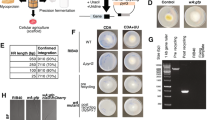Abstract
Tomatoes are an excellent source of the carotenoid lycopene, a compound that is thought to be protective against prostate cancer. They also contain small amounts of flavonoids in their peel (∼5–10 mg/kg fresh weight), mainly naringenin chalcone and the flavonol rutin, a quercetin glycoside. Flavonols are very potent antioxidants, and an increasing body of epidemiological data suggests that high flavonoid intake is correlated with a decreased risk for cardiovascular disease. We have upregulated flavonol biosynthesis in the tomato in order to generate fruit with increased antioxidant capacity and a wider range of potential health benefit properties. This involved transformation of tomato with the Petunia chi-a gene encoding chalcone isomerase. Resulting transgenic tomato lines produced an increase of up to 78 fold in fruit peel flavonols, mainly due to an accumulation of rutin. No gross phenotypical differences were observed between high-flavonol transgenic and control lines. The phenotype segregated with the transgene and demonstrated a stable inheritance pattern over four subsequent generations tested thus far. Whole-fruit flavonol levels in the best of these lines are similar to those found in onions, a crop with naturally high levels of flavonol compounds. Processing of high-flavonol tomatoes demonstrated that 65% of flavonols present in the fresh fruit were retained in the processed paste, supporting their potential as raw materials for tomato-based functional food products.
This is a preview of subscription content, access via your institution
Access options
Subscribe to this journal
Receive 12 print issues and online access
$209.00 per year
only $17.42 per issue
Buy this article
- Purchase on Springer Link
- Instant access to full article PDF
Prices may be subject to local taxes which are calculated during checkout






Similar content being viewed by others
References
Shintani, D. & DellaPenna, D. Elevating the vitamin E content of plants through metabolic engineering. Science 282, 2098–2100 (1998).
Ye, X. et al. Engineering the provitamin A (beta-carotene) biosynthetic pathway into (carotenoid-free) rice endosperm. Science 287, 303–305 (2000).
Romer, S. et al. Elevation of the provitamin A content of transgenic tomato plants. Nat. Biotechnol. 18, 666–669 (2000).
Middleton, E. & Kandaswami, C. The impact of plant flavonoids on mammalian biology: implications for immunity, inflammation and cancer. In The flavonoids: advances in research since 1986. (ed. Harbourne, J.B.) 619–652 (Chapman and Hall, London; 1994).
Hertog, M.G.L. et al. Flavonoid intake and long term risk of coronary heart disease and cancer in the 7 Countries study. Arch. Intern. Med. 155, 381–386 (1995).
Hertog, M.G.L., Feskens E.J.M., Hollman P.C.H., Katan M.B. & Kromhout D. Dietary antioxidant flavonols and risk of coronary heart disease risk—the Zutphen elderly study. Lancet 342, 1007–1011 (1993).
Knekt, P., Jarvinen, R., Reunanen, A. & Maatela, J. Flavonoid intake and coronary mortality in Finland: a cohort study. Br. Med. J. 312, 478–481 (1996).
Weisshaar, B. & Jenkins, G.I. Phenylpropanoid biosynthesis and its regulation. Curr. Opin. Plant Biol. 1, 251–257 (1998).
Mol, J., Grotewold, E. & Koes, R. How genes paint flowers and seeds. Trends Plant Sci. 3, 212–217 (1998).
Dixon, R.A. & Steele, C.L. Flavonoids and isoflavonoids—a goldmine for metabolic engineering. Trends Plant Sci. 4, 394–400 (1999).
Krause, M. & Galensa, R. Determination of naringenin and naringenin chalcone in tomato skins by HPLC after solid phase extraction. Z. Lebensmittel 194, 29–32 (1992).
Burbulis, I.E. & Winkel-Shirley, B. Interactions among enzymes of the Arabidopsis flavonoid biosynthetic pathway. Proc. Natl. Acad. Sci. USA 96, 12929–12934 (1999).
Ewald, C., Fjelkner-Modig, S., Johansson, K., Sjoholm, I. & Akesson, B. Effect of processing on major flavonoids in processed onions, green beans, and peas. Food Chem. 64, 231–235 (1999).
van Tunen, A.J. et al. Cloning of the 2 chalcone flavanone isomerase genes from Petunia—co-ordinate light-regulated and differential expression of flavonoid genes. EMBO J. 7, 1257–1263 (1988).
Becker, D., Kemper, E., Schell, J. & Masterson, R. New plant binary vectors with selectable markers located proximal to the left T-DNA border. Plant Mol. Biol. 20, 1195–1197 (1992).
Fillatti, J.J., Kiser, J., Rose, R. & Comai, L. Efficient transfer of a glyphosate tolerance gene into tomato using a binary Agrobacterium tumefaciens vector. Bio Technology 5, 726–730 (1987).
Hertog, M.G.L., Hollman, P.C.H. & Venema, D.P. Optimization of a quantitative HPLC determination of potentially anticarcinogenic flavonoids in vegetables and fruits. J. Agric. Food Chem. 40, 1591–1598 (1992).
Sambrook, J. et al. Molecular cloning. A laboratory manual. (Cold Spring Harbor Laboratory Press, Cold Spring Harbor, NY; 1989).
Acknowledgements
The authors wish to thank Dr. Adel Elsheikh and Dr. Jinguo Hu (Lipton Innovation Centre, Stockton, CA) for their assistance with transgenic field trials. We also thank Bob Cowper, Carl Jarman, Tracey Macdonald, and Katherine Redwood (URC, Sharnbrook, UK) for their technical contributions.
Author information
Authors and Affiliations
Corresponding author
Rights and permissions
About this article
Cite this article
Muir, S., Collins, G., Robinson, S. et al. Overexpression of petunia chalcone isomerase in tomato results in fruit containing increased levels of flavonols. Nat Biotechnol 19, 470–474 (2001). https://doi.org/10.1038/88150
Received:
Accepted:
Issue Date:
DOI: https://doi.org/10.1038/88150
This article is cited by
-
Overexpression of a Flavonol Synthase Gene from Apocynum venetum Improves the Salinity Stress Tolerance of Transgenic Arabidopsis thaliana
Journal of Soil Science and Plant Nutrition (2023)
-
Quality trait improvement in horticultural crops: OMICS and modern biotechnological approaches
Molecular Biology Reports (2023)
-
Beyond green and red: unlocking the genetic orchestration of tomato fruit color and pigmentation
Functional & Integrative Genomics (2023)
-
Fruit ripening: dynamics and integrated analysis of carotenoids and anthocyanins
BMC Plant Biology (2022)
-
Transcriptomic and metabolomic analysis reveals the difference between large and small flower taxa of Herba Epimedii during flavonoid accumulation
Scientific Reports (2022)



